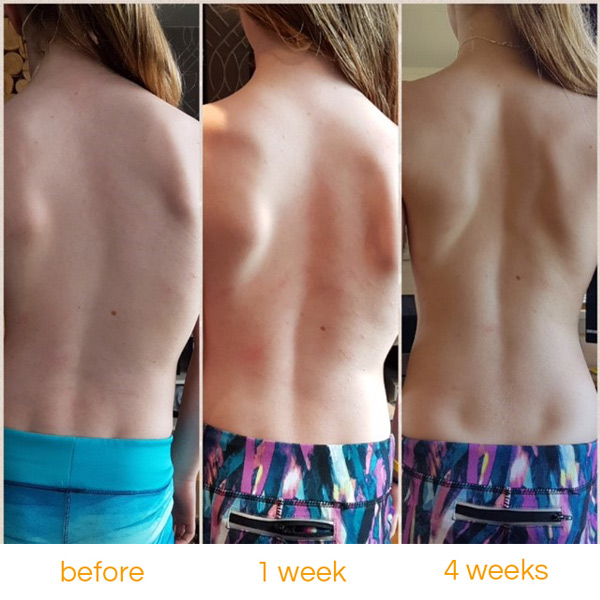A normal spine will have a gentle ‘S’ shape when seen from the side. Naturally, the neck will arch forwards slightly and the lower back (lumbar part of the spine) does the same, also known as lordosis. The thoracic part of the spine (between the shoulder blades) has a slight outward curve, and this is known as kyphosis. A normal back has a 20° to 45° curvature in the upper part of the back, yet anything above 45° is called kyphosis. Kyphosis can cause pain if excessive or if in the wrong place such as the lower back.
Kyphosis refers to excessive curvature of the spine usually present between the shoulder blades, where it curves further backwards than it should. This can cause a person to become more round-shouldered, unable to stand up straight and can cause pain. Kyphosis is broadly characterised as either postural; i.e. caused by poor posture, or structural; caused by a bone, disc, nerve, ligament or muscle abnormality.
For adults, it can be caused by the degeneration of discs and joints of the spine, or as a result of secondary conditions like osteoporosis and Parkinson’s disease. In children, it can be a result of spina bifida. Diagnosis is based on a physical exam.

In young children and adolescents with kyphosis, the most common form is Scheurmann's disorder, sometimes called Scheurmann's disease, characterised when growth spurts occur and the rectangular-shaped vertebrae become compressed and wedged into triangles. With Scheuermann’s, the thoracic curve will typically be between 45° and 75°.
Scheuermann’s is a hyper kyphosis, a more serious deformity than postural kyphosis as the bones have already wedged and deformed. Symptoms can develop between the ages of 10 and 15. Patients with the condition may have a visual ‘hunchback’ and can experience lower or mid-level back pain or neck pain.

Bracing can provide pain relief for those suffering from kyphosis by adjusting the position of the shoulders and pelvis. In the growing patient, we can prevent worsening of the deformity and quickly improve appearance. A bespoke physiotherapy treatment programme, based upon pattern-curve specific Schroth principles, can be used to treat postural Kyphosis, Osteoporosis and Scheuermann’s disease. The programme will aim to improve muscle lengths and spinal extensor strength while reducing postural pain.
Read more about:


Join The London Orthotic Consultancy in celebrating Cerebral Palsy Awareness Day on March 25th. Learn just how important expert orthotic care is in enhancing mobility, independence, and quality of life for children and adults with cerebral palsy.

Introducing the Agilik™ smart orthosis, a cutting-edge, powered knee orthotic now available in the UK through the London Orthotic Consultancy. Unlike traditional KAFOs or heavy exoskeletons, the Agilik™ provides dynamic knee assistance and offers real-time support, reducing fatigue and improving posture. This pioneering, modern technology can help children and adults with lower limb weakness walk more efficiently and naturally. We are honoured to be selected as the exclusive paediatric specialist centre in the UK for the Agilik™ device.

When Sophie noticed her baby Max had a persistent flat spot on his head, she was told it would resolve naturally—but it didn’t. Seeking a second opinion led her to the London Orthotic Consultancy, where Max was diagnosed with severe plagiocephaly.

A little more than four years after the LOCband Lite's launch, we're proud to have successfully treated our 250th helmet therapy patient at our Romford clinic using our cutting-edge 3D-printed cranial band. After five months of treatment, her final scan showed that her asymmetry had decreased from 12 mm to 3 mm.

Sky News published an article this month quoting scientists at Southmead Hospital who claimed there was a lack of research into flat head syndrome and its treatment with cranial remoulding (helmet) therapy. This is our response.

With our non-surgical treatment plan, Alex achieved 100% chest correction in just two years. His treatment involved a combination of dynamic chest compressor and vacuum bell therapy treatment to address his pectus excavatum and rib flaring.

Learn how a custom carbon fibre AFO helped Gill regain mobility and comfort despite complex challenges from shin bone (tibia) removal. We created a truly tailored orthotic solution made from pre-preg carbon fibre at our Cambridge clinic.

Discover how bespoke orthotics and the OSKAR program with Elaine Owen transformed Archie’s life with cerebral palsy quadriplegia, helping him avoid a wheelchair and achieve greater mobility.